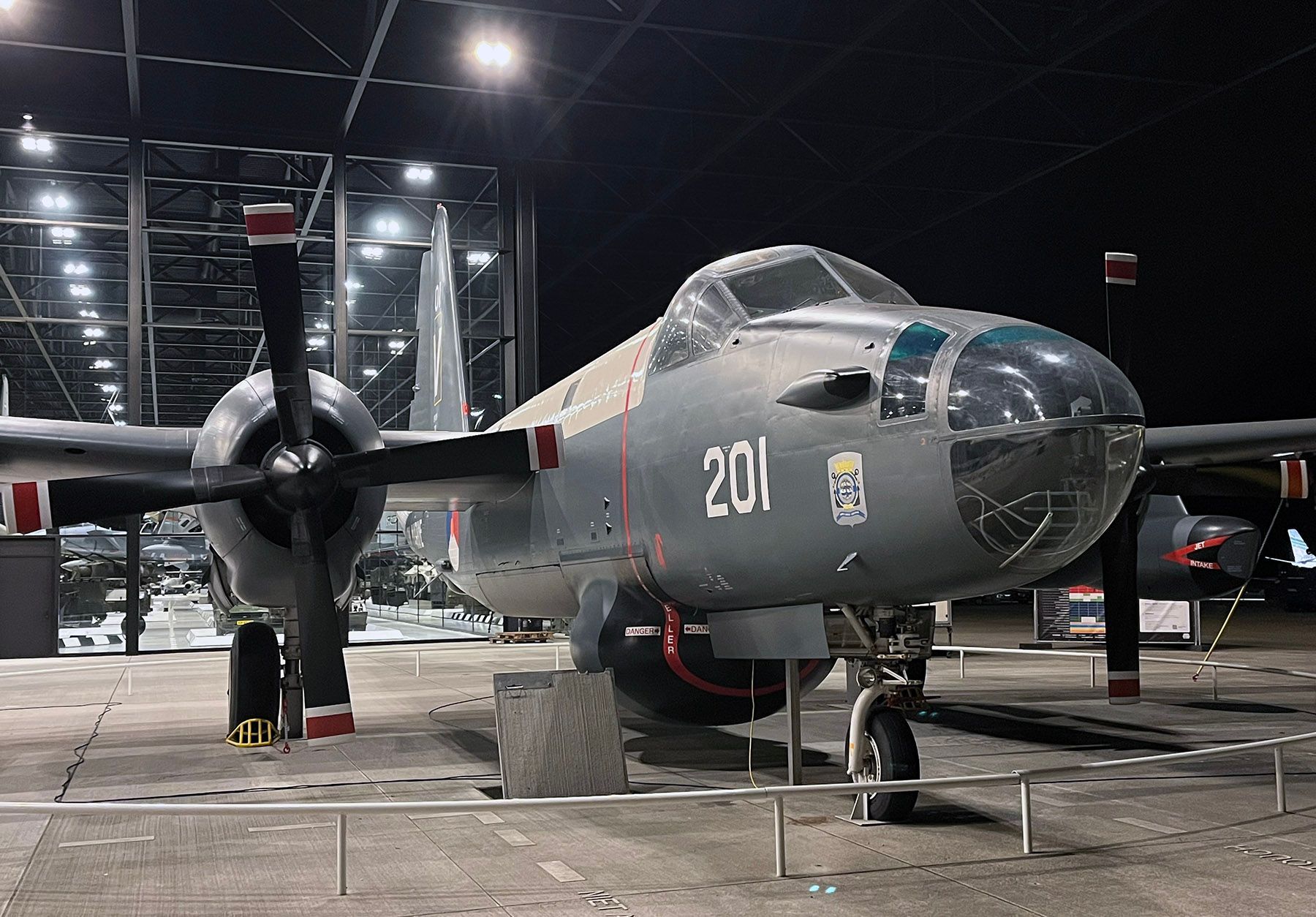On 29 August 2025, the Nationaal Militair Museum (National Military Museum) at Soesterberg, the Netherlands offered a good opportunity to picture part of their collection outside on the tarmac. A welcome gesture, since these aircraft are part of the museum’s depot and rarely accessible to the general public.
Text and photos: Emiel Sloot
10 September 2025
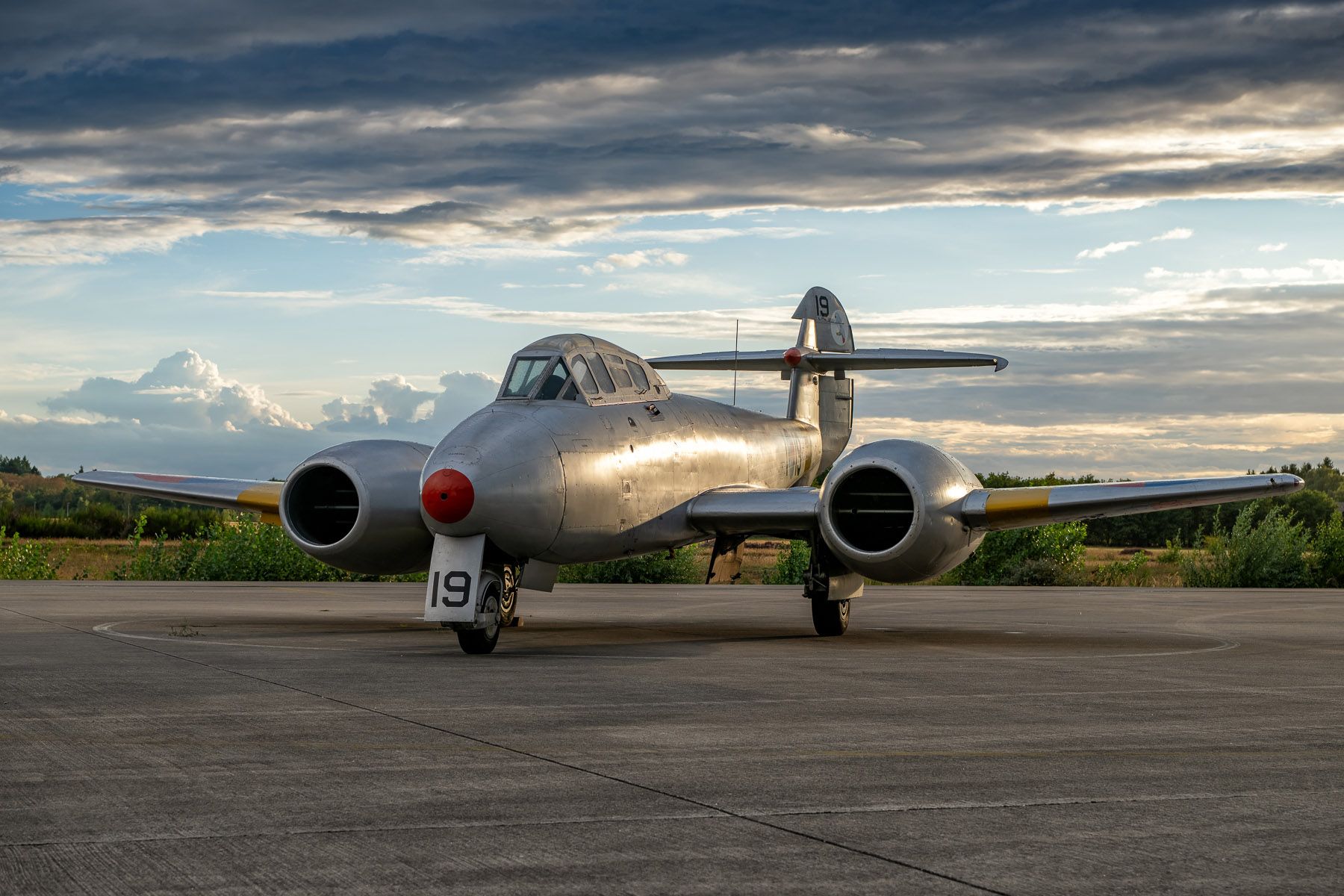
The Nationaal Militair Museum (NMM) is located on a very special former air base, being the birthplace of military aviation in the Netherlands. On 1 July 1913, the Luchtvaartafdeeling (LVA) was established here and operations commenced with a single rented plane called ‘Brik’.
Fast forward to almost a century later. Following a series of defence cutbacks, Soesterberg air base closed on 12 November 2008 after the last based helicopters of the Koninklijke Luchtmacht (KLu – Royal Netherlands Air Force) had relocated. While a large part became a park, it also offered a great opportunity to move the collections of both the air force and army museums to a new and larger location. As a result, the NMM opened its doors in December 2014. Not all air activity had seized by the way, as the local glider club is currently still active in a corner of the former air base.
Late August 2025, the museum towed part of their stored collection outside for the annual ‘Zomeroffensief’ event. In this report, we highlight seven of these historic aircraft. Literally, as all of these were placed in the spotlights for a well-organised nightshoot.
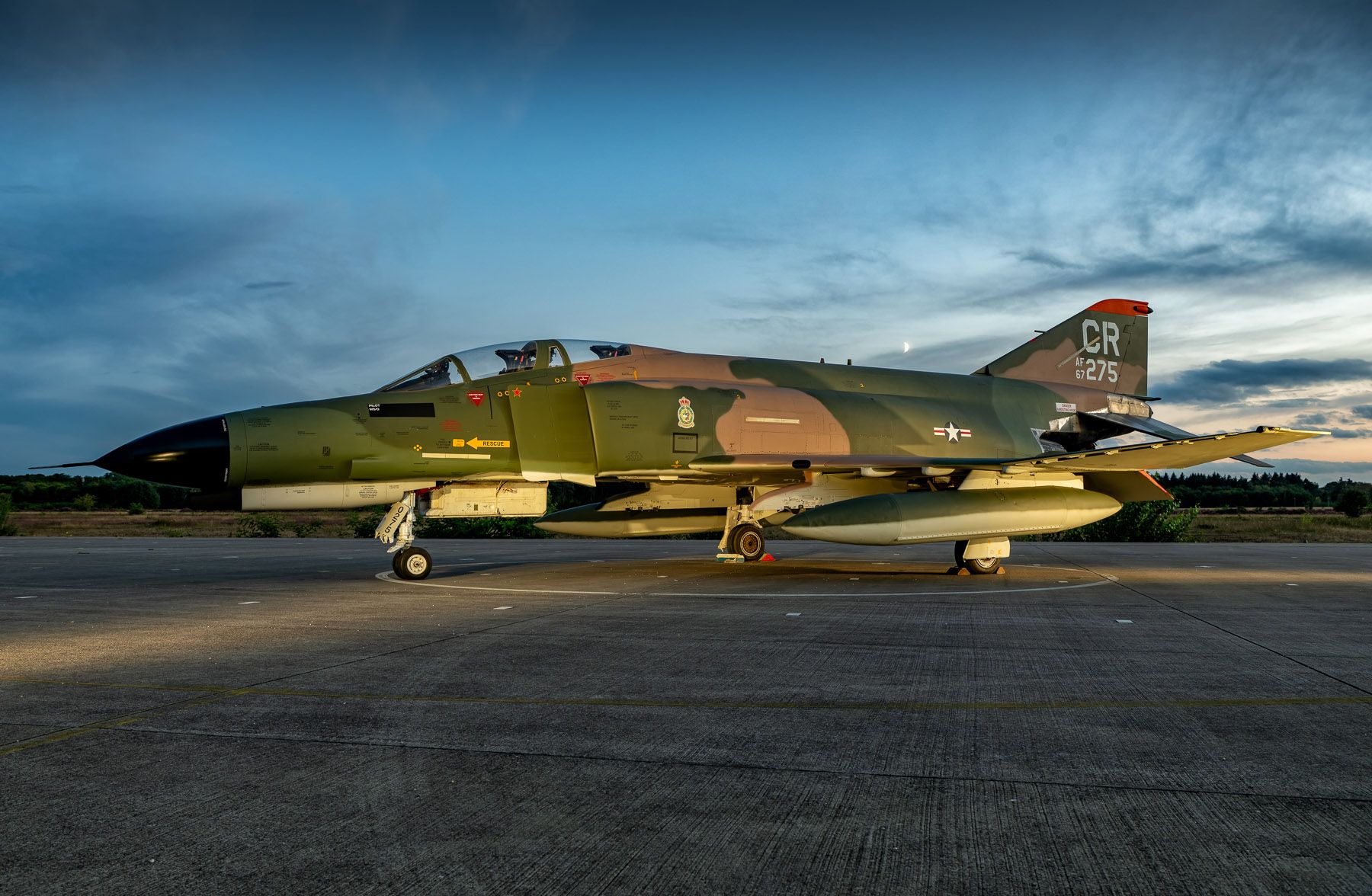

McDonnell Douglas F-4E Phantom II serial 67-0275
During the Cold War, the United States Air Force in Europe had a base in Soesterberg that was referred to as Camp New Amsterdam. From 1954 until its disbandment in 1994, it was home to the 32nd squadron in various forms: 32nd Fighter-Day Squadron; 32nd Fighter Intercepter Squadron; 32nd Tactical Fighter Squadron; and finally 32nd Fighter Squadron. What’s in a name.
For about a decade, the unit was equipped with the McDonnell Douglas F-4E Phantom II in the air defence role, maintaining a quick reaction alert (QRA) against possible intruders into NATO airspace. The Phantoms replaced Convair F-102A Delta Dagger interceptors in 1969, and on their turn made way for McDonnell Douglas F-15A Eagles in 1978.
Over the years, the museum made efforts to display the various types that served with the 32nd. They did succeed. Yet, there is more to it. A North American F-86F Sabre was found in Portugal – a former aircraft of that air arm – and repainted in USAF colours. Unfortunately, it has been placed outside for years now, and the weather and sun do not do any good to its shape. Exactly this already had resulted in both the displayed F-102A Delta Dagger (a former Hellenic Air Force aircraft) and North American F-100F Super Sabre (ex French Air Force) ending up in such a bad state that extensive restoration became necessary. A crowd funding helped getting the Super Sabre a.k.a. the ‘Hun’ return into an immaculate exhibition, but soon after it was decided to permanently remove it from the collection due to lack of space, a move that left many enthusiasts in disbelief. One can only hope that the F-102 that is currently being restored, will be treated better in the end.
Fortunately, it’s not all bad news. Although not part of the permanent display like the museum’s F-15A Eagle, they have a beautifully restored F-4E Phantom in storage. Since this aircraft is actually owned by the USAF museum, it will certainly be looked after with great care. On various occasions, the Phantom is being towed out of the depot to show off.
F-4E-35-MC 67-0275 (c/n 3011) is painted in the colour scheme that was common during the unit’s Phantom years, and wears 32nd TFS markings. While carrying its true serial number, this aircraft never operated from Soesterberg, although it did fly with the USAFE briefly in the early 1980s – at Hahn Air Base, Germany with the 50th Tactical Fighter Wing to be exact. Phantom II 67-0275 first flew on 15 May 1968 and not only served with various units, it is also a Vietnam War veteran and as such it scored a MiG-21 kill, as can be witnessed by the star marking on the air intake splitter plate. The aircraft retired from active service on 25 September 1989 and was stored at Davis Monthan AFB, Arizona. Years later, it was transported by sea to the Netherlands via Belgium, where it was resprayed in its current livery and markings. Since August 2011 it is part of the NMM’s collection, although still owned by the USAF Museum at Dayton, Ohio.
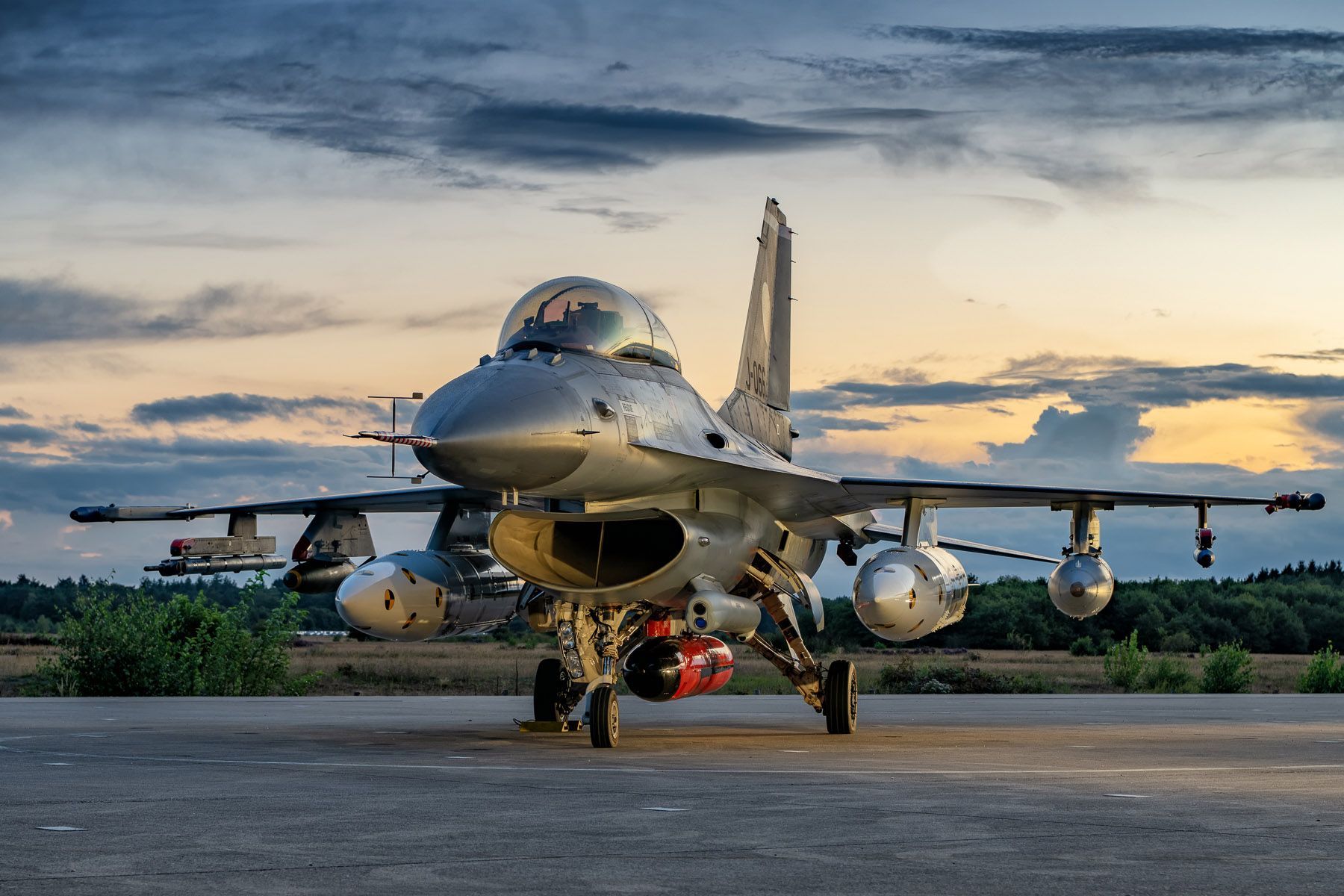
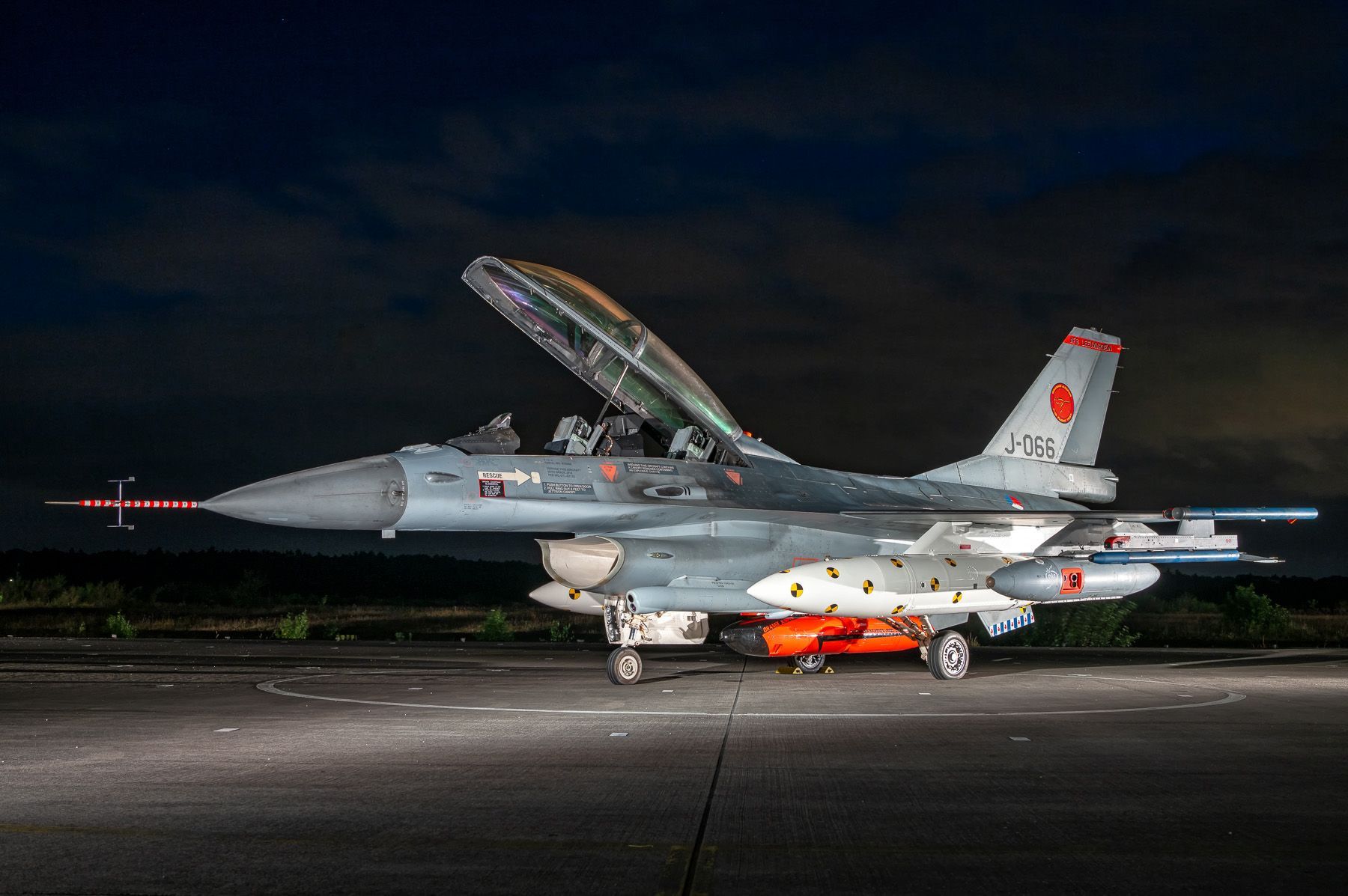
General Dynamics/Lockheed Martin F-16BM Fighting Falcon serial J-066
On 27 September 2024 the Royal Netherlands Air Force retired their last of a total of 213 F-16s. Many of these have found their way to a new military owner over the years, while others were retained for various purposes like ground instruction or local monuments. Fortunately, the NMM could get their hands on a few as well and that includes F-16BM J-066, a very special one indeed.
Like all Dutch F-16s, J-066 (c/n 6E-35, FMS 87-0066) was built by Fokker at Schiphol as the 264th F-16 that rolled off that particular assembly line. This F-16B first flew on 19 May 1989 and was subsequently delivered to Twenthe Air Base on 23 June 1989 where it was taken on charge with 315 squadron. It thereafter served with other units before being upgraded under the Mid-Life Update (MLU) programme early 1998, thus becoming an F-16BM. It continued operational service for awhile, but in June 1999 it was adopted by the Kantoor Testvliegen (RNLAF Test Group) at Leeuwarden Air Base. A modified, enlarged pitot tube dubbed ‘Viagra Boom’ was applied and the airframe was fitted with many lengthy ‘jumper’ cables to connect test equipment and sensors, all orange-coloured. For that reason, J-066 became known as Orange Jumper, explaining the large orange kangaroo batch depicted on the vertical tail.
With F-16 operations at Leeuwarden coming to a close in July 2021, J-066 relocated to Volkel Air Base but only flew there for a brief period before being phased out, completing its last flight on 31 March 2022. It was subsequently handed over to the NMM and transported to Soesterberg by road in 2023.
For the 2025 nightshoot, J-066 was carrying an interesting array of external stores that were used in its testing days. Of particular note are the Nationaal Lucht- & Ruimtevaart (NLR)-adapted travelpod on Station 3; the BAe Systems Falcon Owl FLIR navigation pod (aka Airborne Targeting Low-Altitude Navigation Thermal Imaging and Cueing or ATLANTIC) on Station 5A; and the centreline-mounted instrumentation pod, being a converted Orpheus reconnaissance pod that was once carried by the F-16A(R).
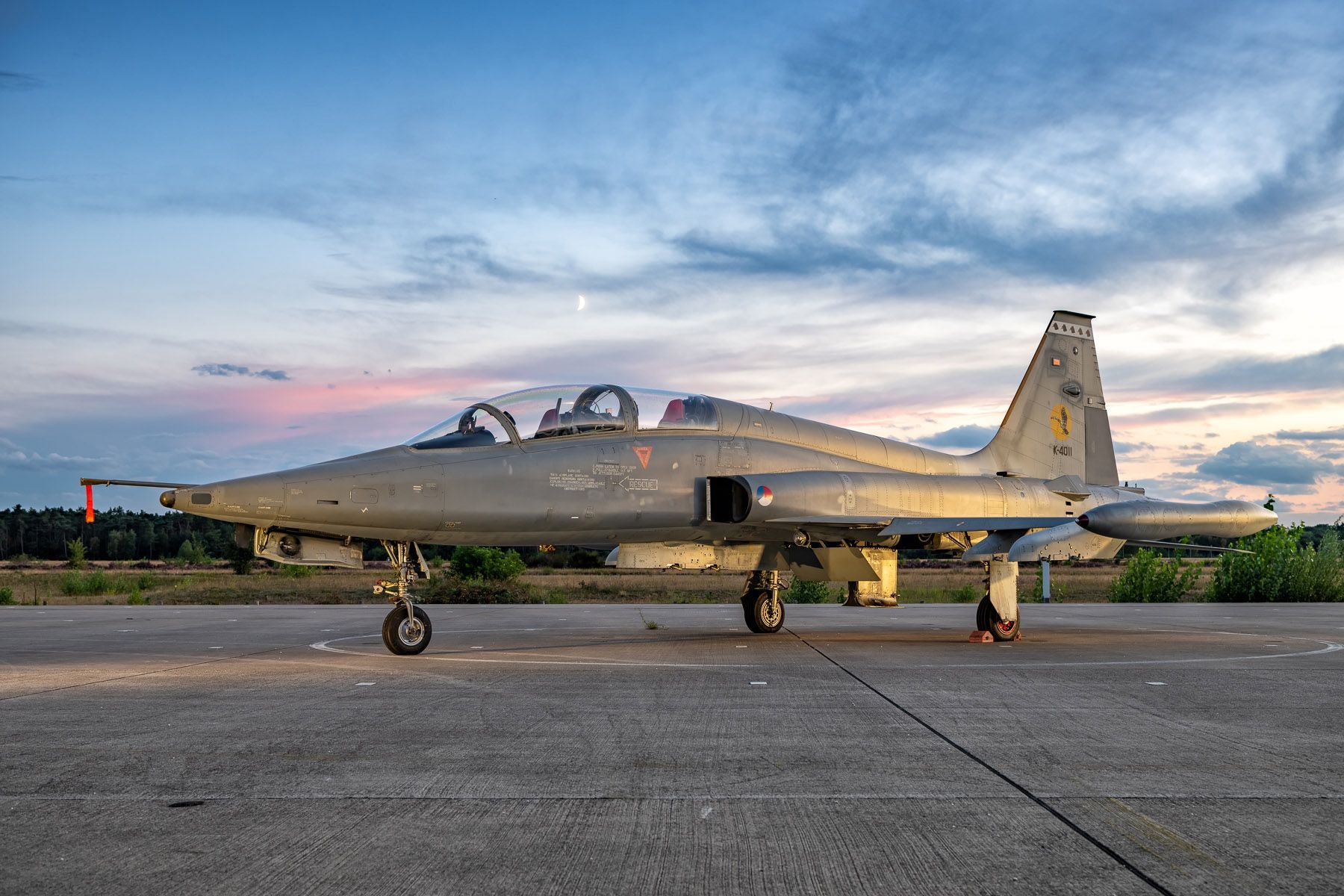
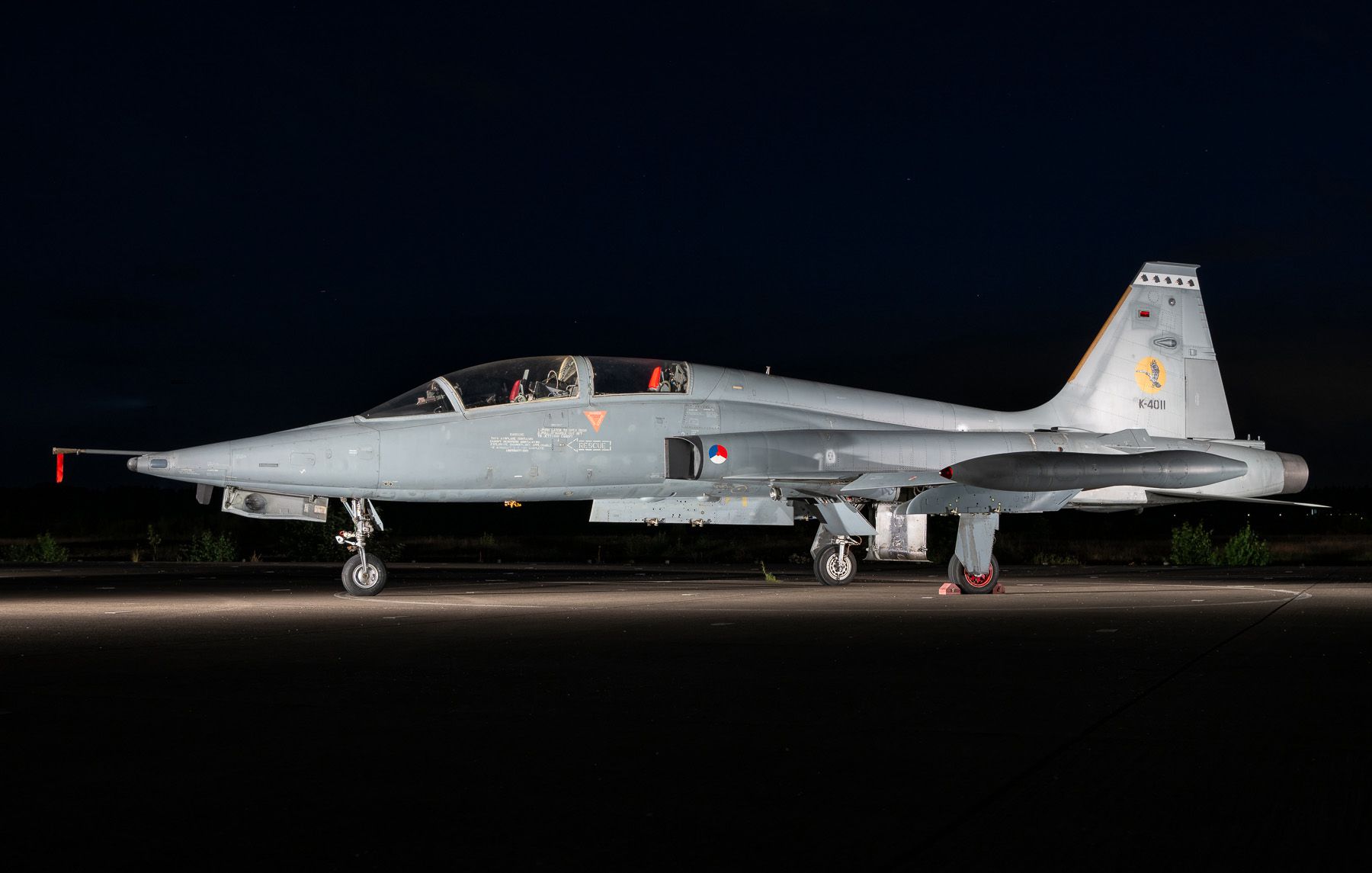
Northrop/Canadair NF-5B serial K-4011
I have always appreciated the NF-5’s appearance, particularly since I witnessed many of those while flying from Twenthe Air Base during the 1970s. Two squadrons – 313 and 315 – were based there, and at the time 313 squadron was the air force’s main operator of the dual-seat NF-5B variant. This was related to their Theatre Operational Conversion Course role. New fighter pilots that had graduated in Canada, or from 1990 in the United States, would first undergo this course to get accustomed to the European conditions, as most of their initial flying was carried out in severe CAVOK conditions, e.g. no significant cloud cover and unlimited visibility. The regular low ceilings as well as frequent limited visibility during the darker part of the year in the Netherlands and surrounding countries posed a challenge to safely operate. Following the TOCC course, the graduated fighter pilot would either remain flying NF-5s or convert to the F-104G Starfighter, or F-16A in the later years.
NF-5B K-4011 (c/n 4011) was one of 30 dual-seat aircraft, along with 75 single-seat NF-5As. All were built by Canadair and were delivered between 1969 and 1972 during several so-called High Flights. These originated at Bagotville, Quebec and ended after five legs in Twenthe Air Base. Along with K-4001, K-4009 and K-4010, NF-5B K-4011 was part of the second High Flight and arrived at Twenthe on 17 December 1969. Initially it was used by 315 squadron for a first series of conversion courses, until it transferred to Gilze-Rijen where 316 squadron reactivated on 1 July 1971. For the remainder of its career, K-4011 would be allocated to that particular unit.
On 2 August 1982, K-4011 was the first NF-5 to log 2,500 flying hours and from 1 August 1986, 316 squadron took over the earlier mentioned TOCC task from 313 squadron. Meanwhile, the air force had experimented with new grey camouflage schemes for their NF-5s, ultimately choosing the third variant being all grey. On 28 January 1987, K-4011 rejoined 316 squadron in that appearance. Not for long however, as by December that year it was decided to withdraw K-4011 from service. Following inspection, the condition of its airframe was considered to be too bad to hand it over to a new potential user. Therefore, it was transported to the then Militaire Luchtvaart Museum in Kamp Zeist on 28 August 1989, and subsequently joined the NMM collection where it was officially handed over on 17 June 1991.
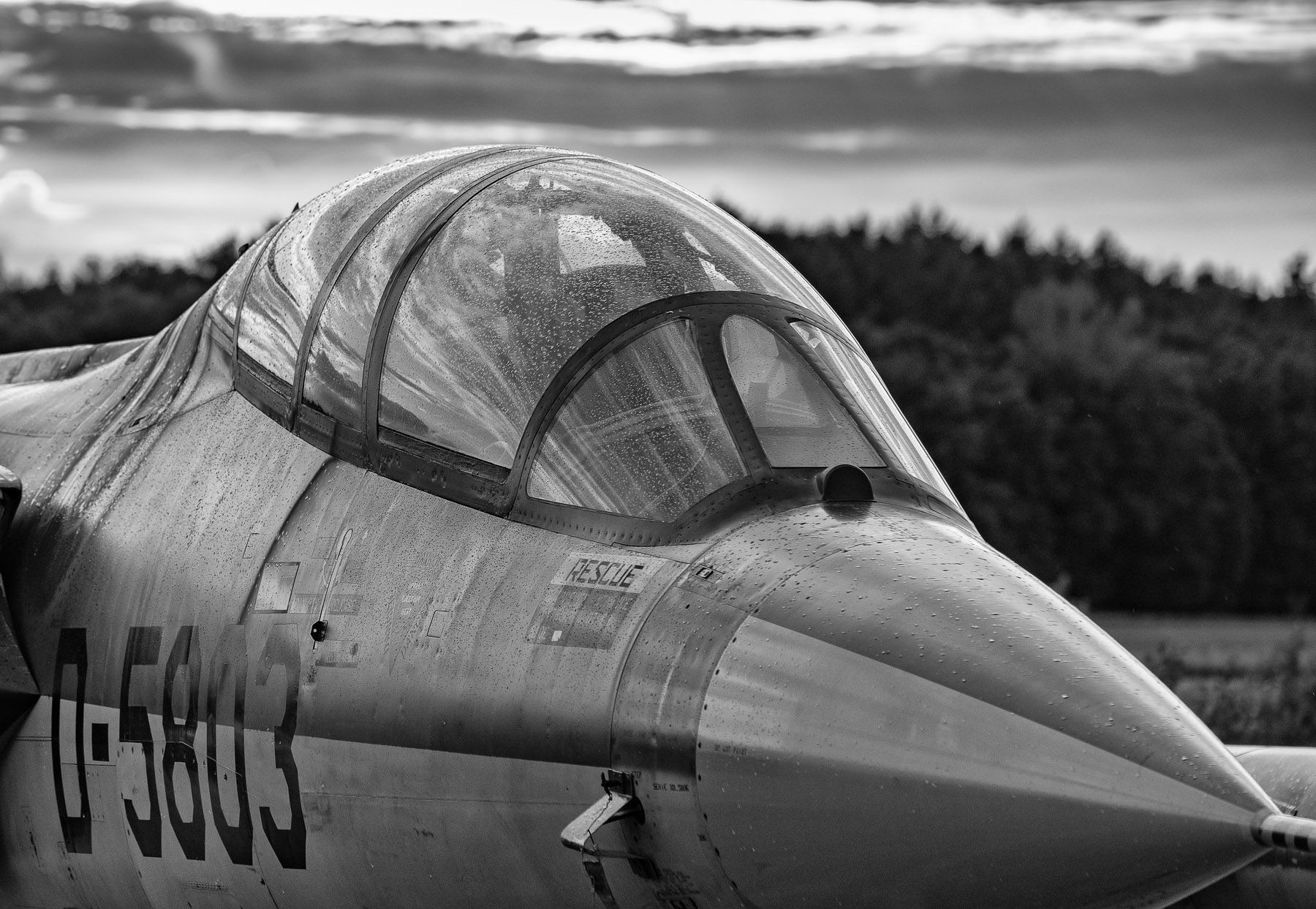
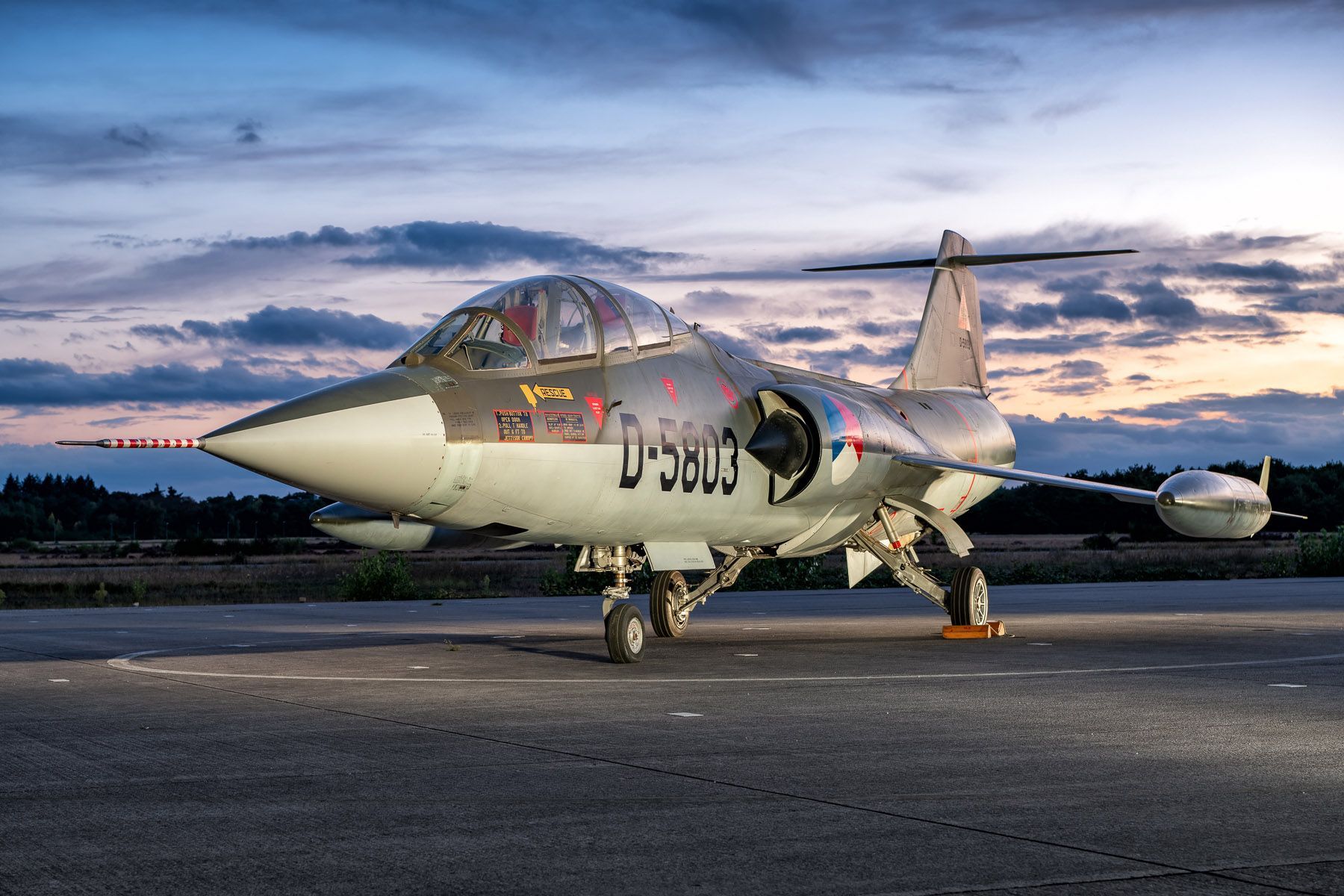
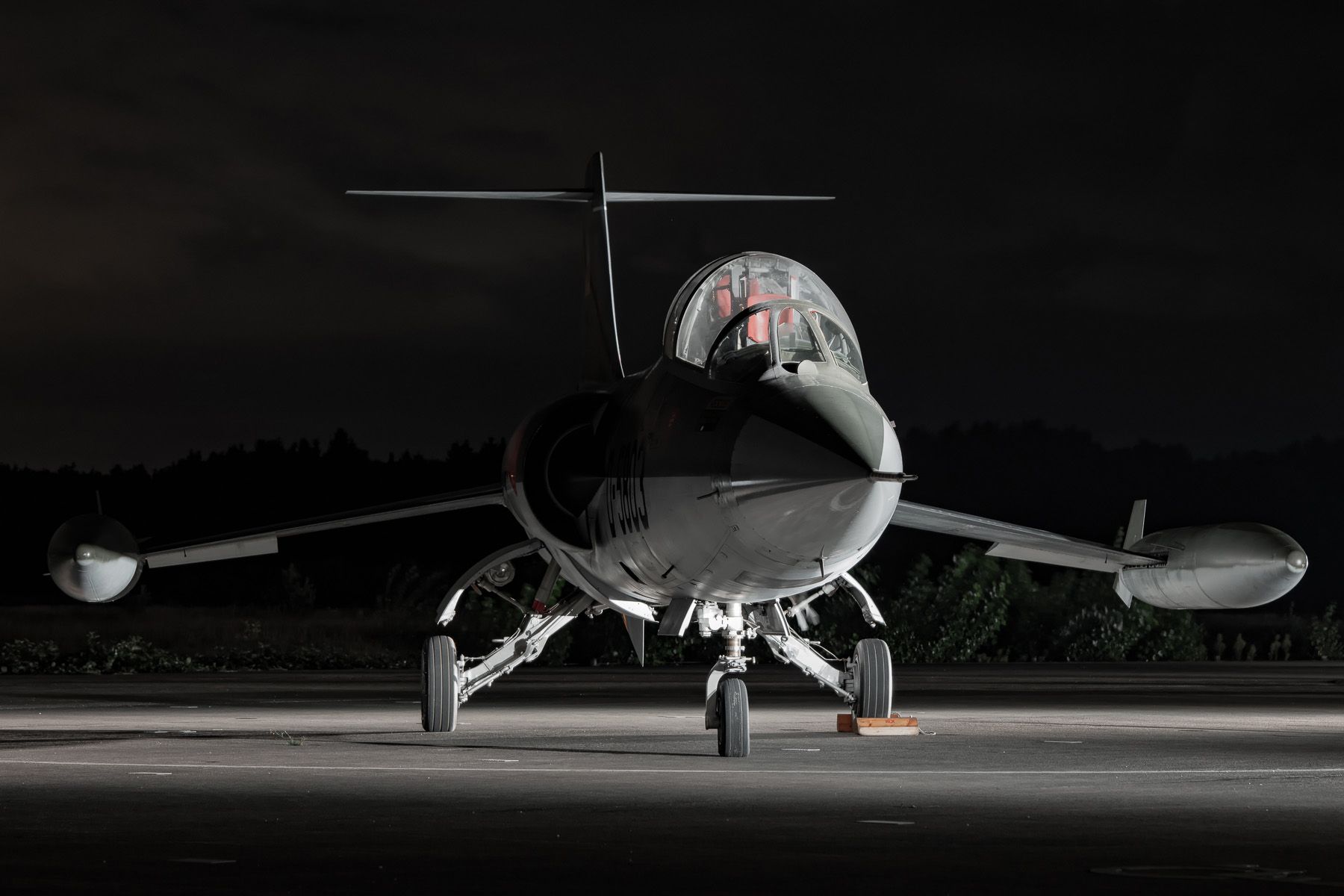
Lockheed TF-104G Starfighter serial D-5803
The iconic Starfighter with its distinctive sound was used by the Koninklijke Luchtmacht between 1962 and 1984. Five operational squadrons operated 120 Lockheed F-104Gs that were mainly built by Fokker at Schiphol, while 25 of these were FIAT-made in Italy and supplied under the Mutual Defense Assistance Program (MDAP) by the United States.
For pilot conversion purposes, the KLu also bought 18 dual-seat TF-104G aircraft. These were all built by Lockheed and airlifted from Burbank, California to the Netherlands. As such, the NMM’s D-5803 (c/n 583E-5803) arrived at Twenthe Air Base on 9 August 1963 in the belly of a Canadair CL-44 of Flying Tiger Lines. After being reassembled, it joined the Operational Conversion Unit nicknamed ‘Dutch Masters’.
On 26 July 1966, D-5803 moved to Volkel Air Base to become part of the local Conversie All-Weather Vlucht, although commonly known as Conversie Afdeling Volkel, a Starfighter conversion unit that trained pilots for strike squadrons 311 and 312 as well as photo reconnaissance unit 306 squadron. It would eventually be a long-time resident, even till the very end. To accommodate the type’s last months of operation, the Uitfaseringsonderdeel (UFO) F-104 formed on 1 July 1984 and D-5803 became part of it. On 21 November that same year, the official final Dutch Starfighter flight took place which took the 5-ship formation – including D-5803 – over the air force’s various bases and locations. D-5803’s very last flight occurred on 26 November when it was flown to Ypenburg for long-term storage.
A small museum at Twenthe took care of D-5803 when it received the dual-seater in September 1988. Here, it was displayed alongside a Gloster Meteor (the very same one mentioned later in this article). In advance of the base’s closure, it was relocated to Soesterberg in the spring of 2005.
Currently it is displayed with a ‘Dutch Masters’ badge on the vertical stabilizer, referring to its first unit.
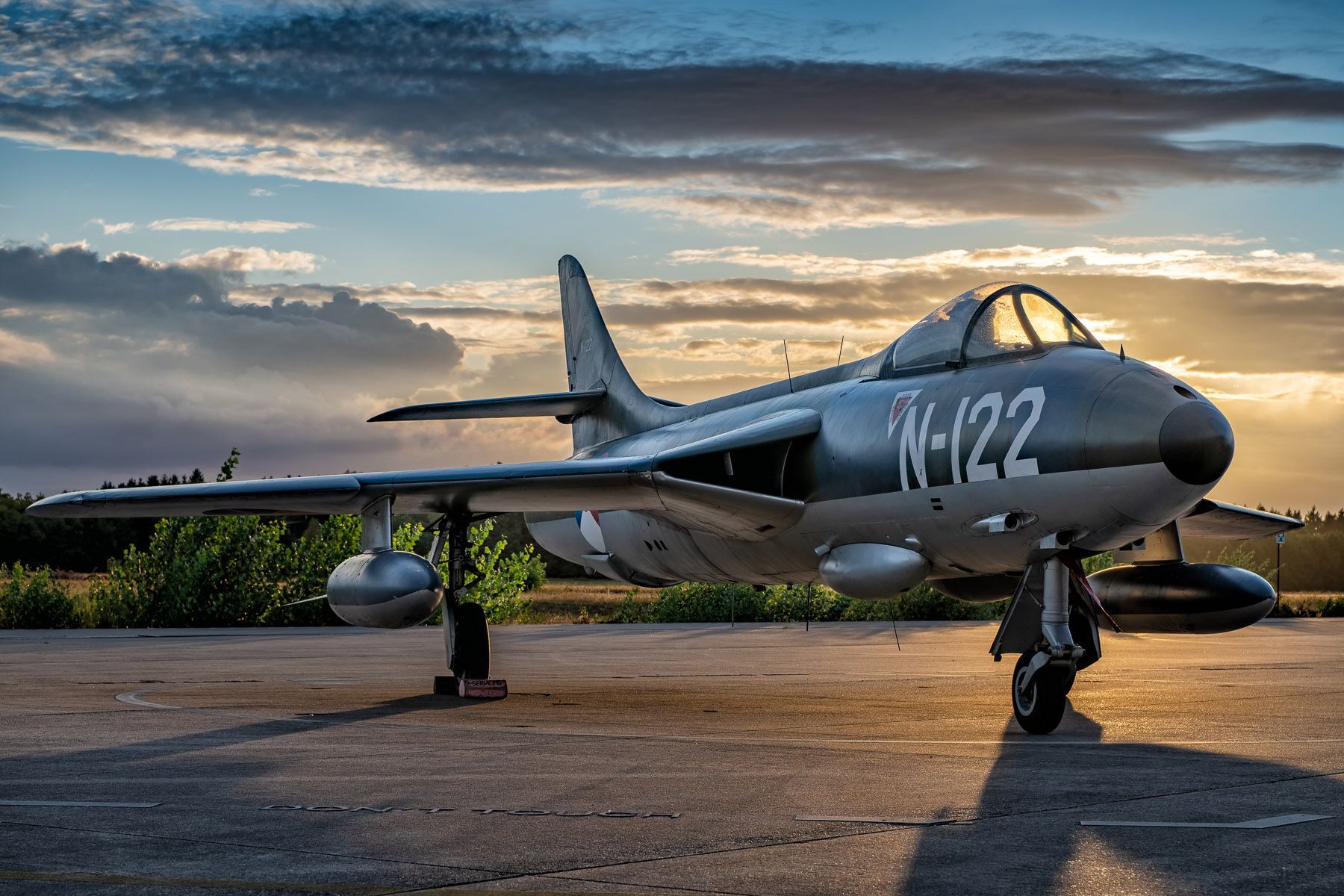
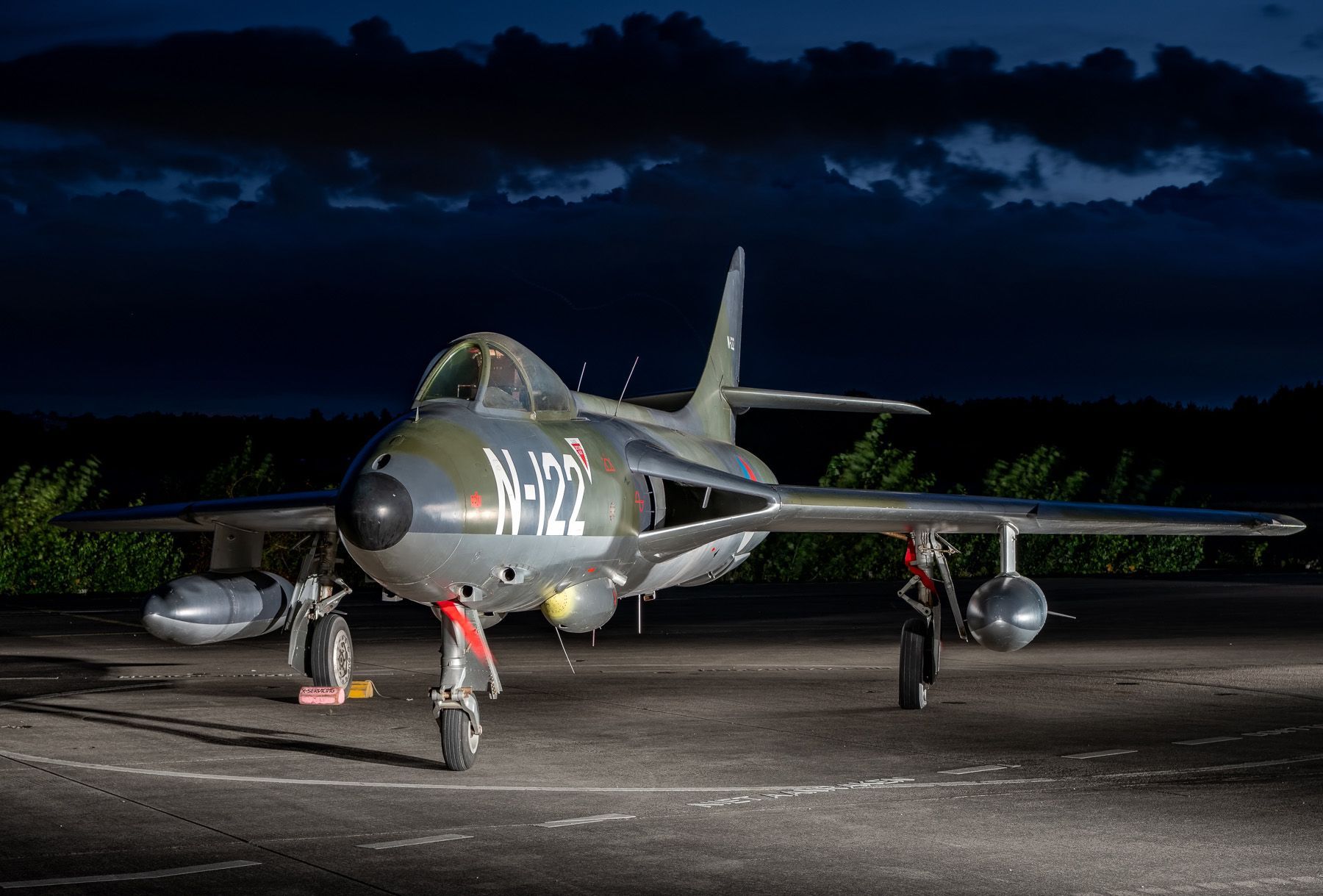
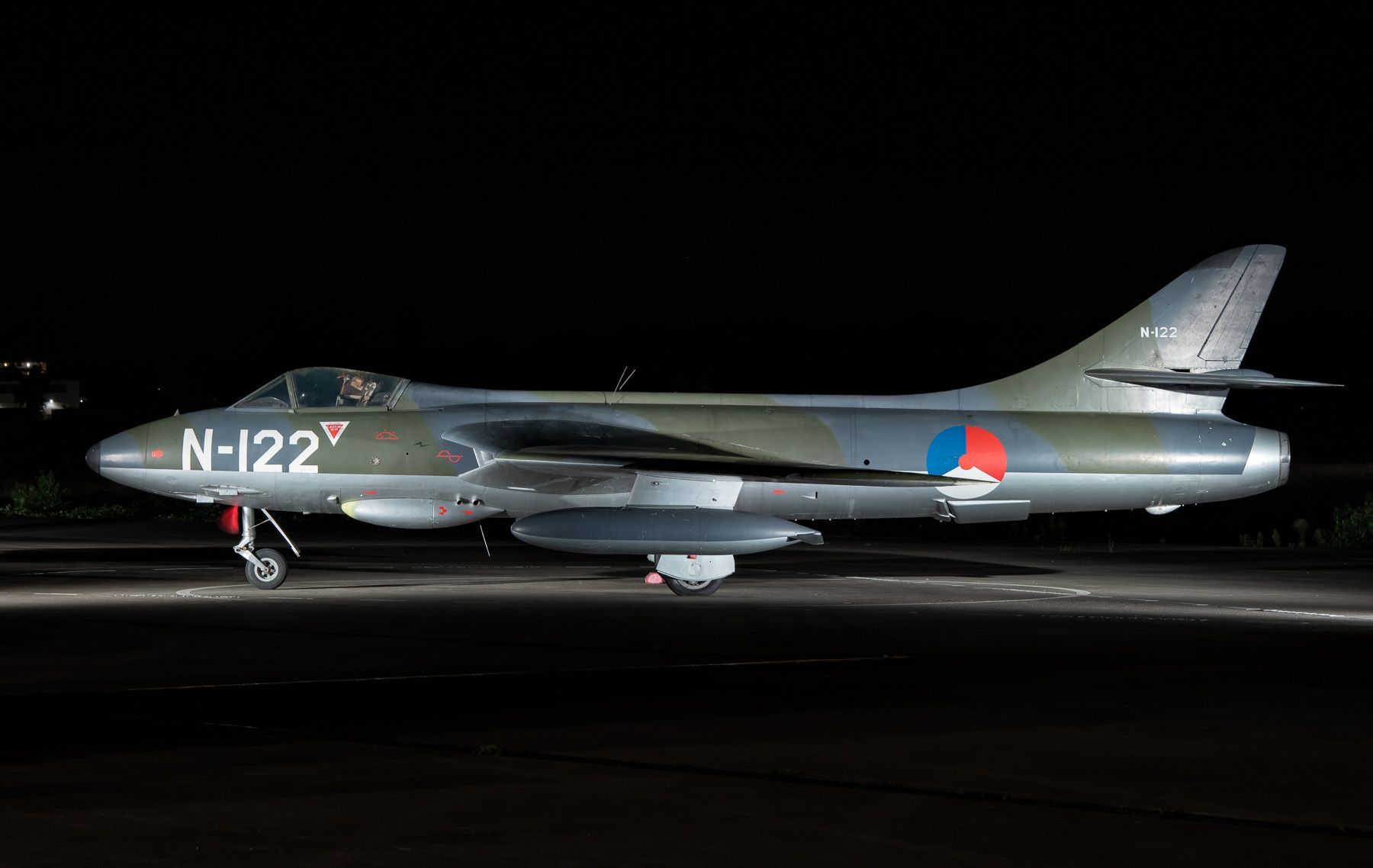
Hawker Hunter F. Mk 4 serial N-122
While the previously mentioned aircraft of course gained a lot of attraction from the visiting pixel collectors, the real stars of the nightshoot - in my humble opinion - would be found a bit further down the lighted flight line.
After evaluation of a few different fighter types available at the time, the Koninklijke Luchtmacht chose the Hawker Hunter F. Mk 4 as successor for their outdated Gloster Meteors. A total of 96 were licence-built by Fokker and delivered between 29 December 1955 and 31 October 1957. These served six air defence squadrons. While the last F. Mk 4s rolled off the production line, the delivery of 93 additional Hunter F. Mk 6 aircraft soon followed, augmenting as well as replacing the former variant. The last flight of a F. Mk 4 took place on 30 August 1963. By the way, the KLu also operated 20 T. Mk 7 side-by-side trainers for pilot conversion.
On the pictures we see Hunter F. Mk 4 N-122, a long-time museum resident as it was adopted into the collection already in 1968. N-122 was delivered to 325 squadron at Leeuwarden on 24 April 1956. When 326 squadron at Woensdrecht exchanged their Meteors for Hunters in November 1957, N-122 joined that unit until returning to Leeuwarden in October 1958 for service with 323 squadron. After logging just 387 flying hours, N-122 was put into storage on 31 May 1960 to become a travelling exhibit. Since 1968, it is part of the air force museum collection.
In its current appearance, it does not wear any squadron markings, however back in the 1980s it was frequently displayed with the distinctive scorpion squadron badge of 325 squadron, a unit that was once based at Soesterberg from 27 March 1958 till its disbandment on 1 September 1968 as the last operational KLu Hunter squadron. For this reason, I would certainly welcome the re-application of that particular badge that would fit perfectly on this extremely elegant fighter!
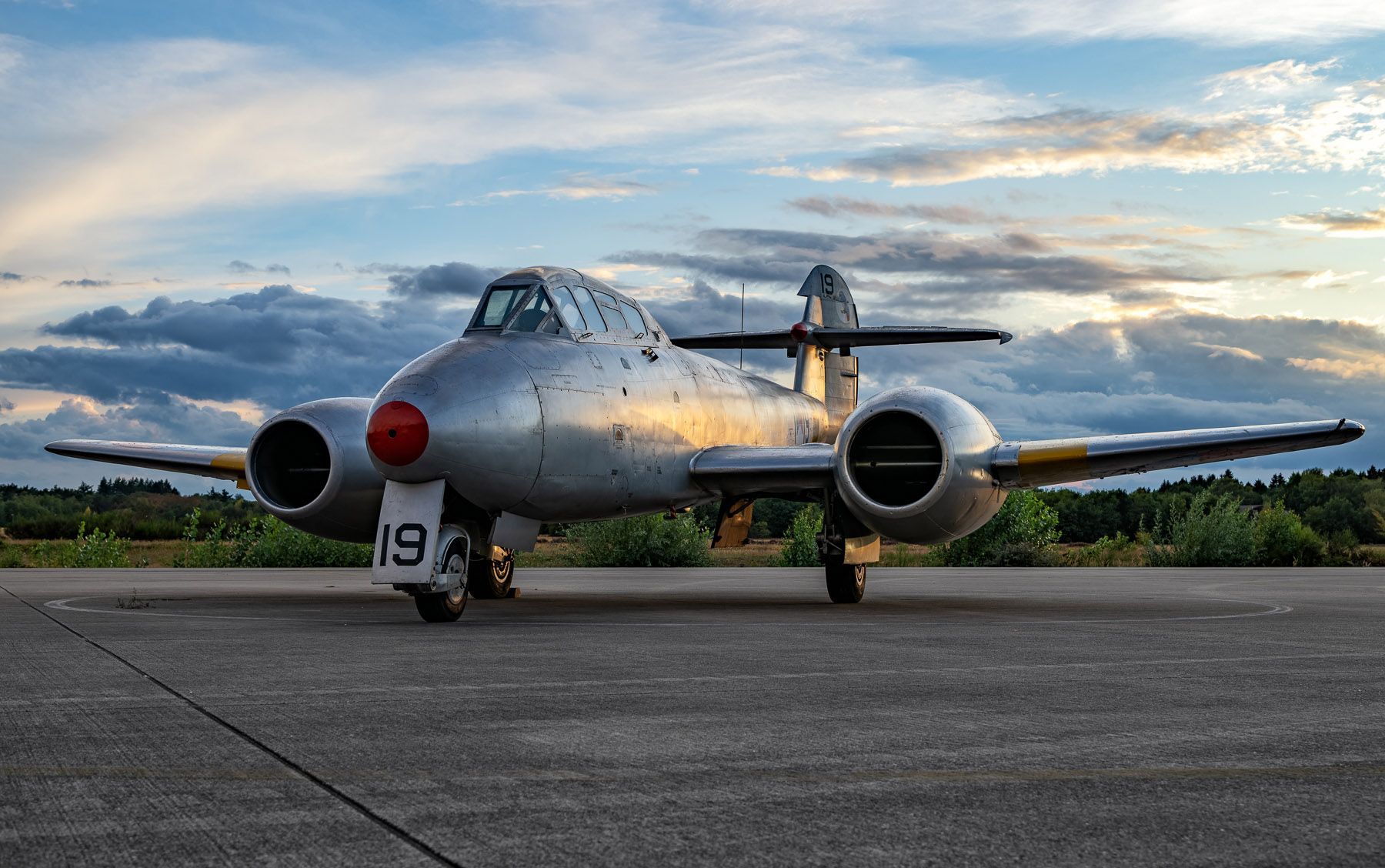
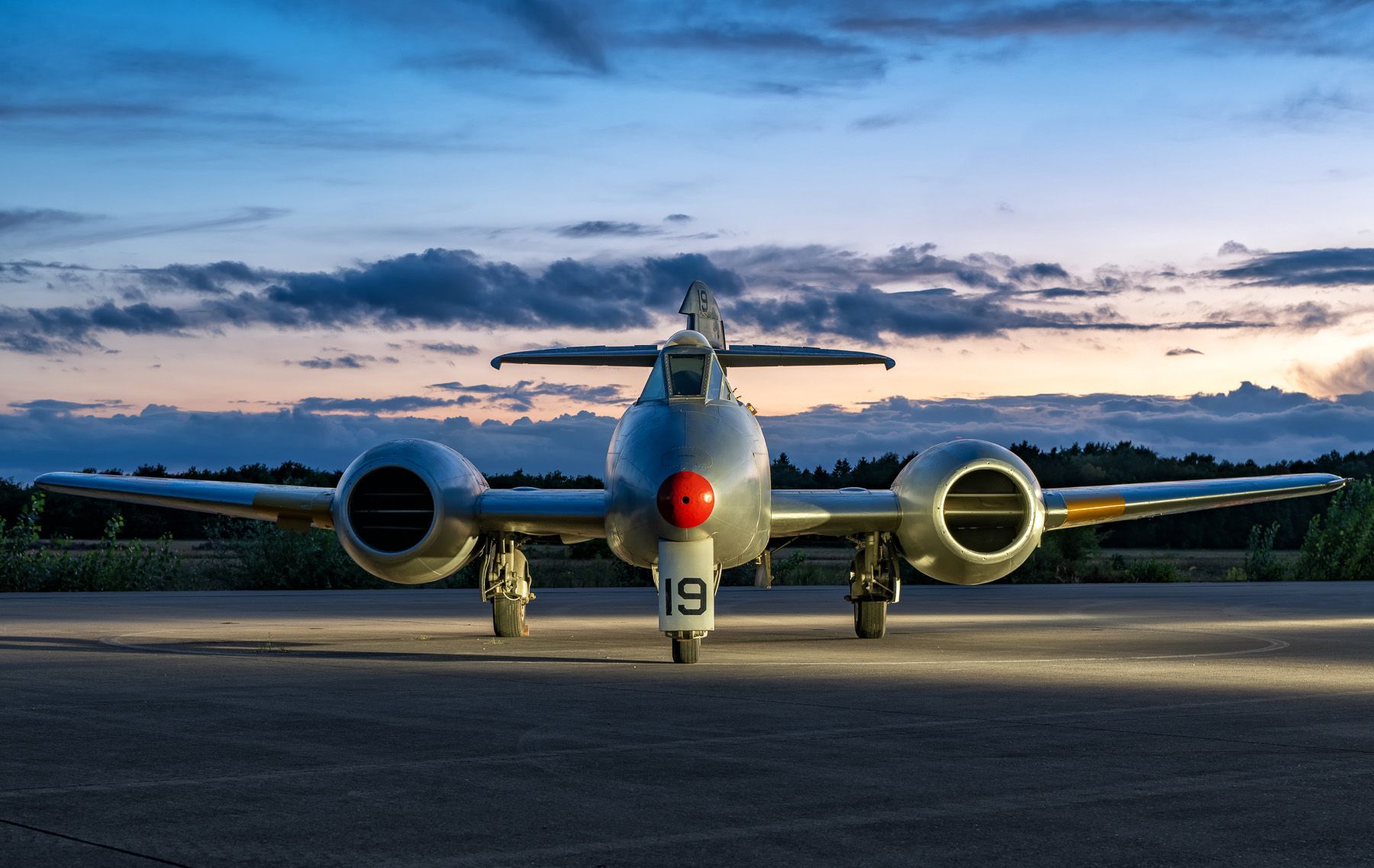
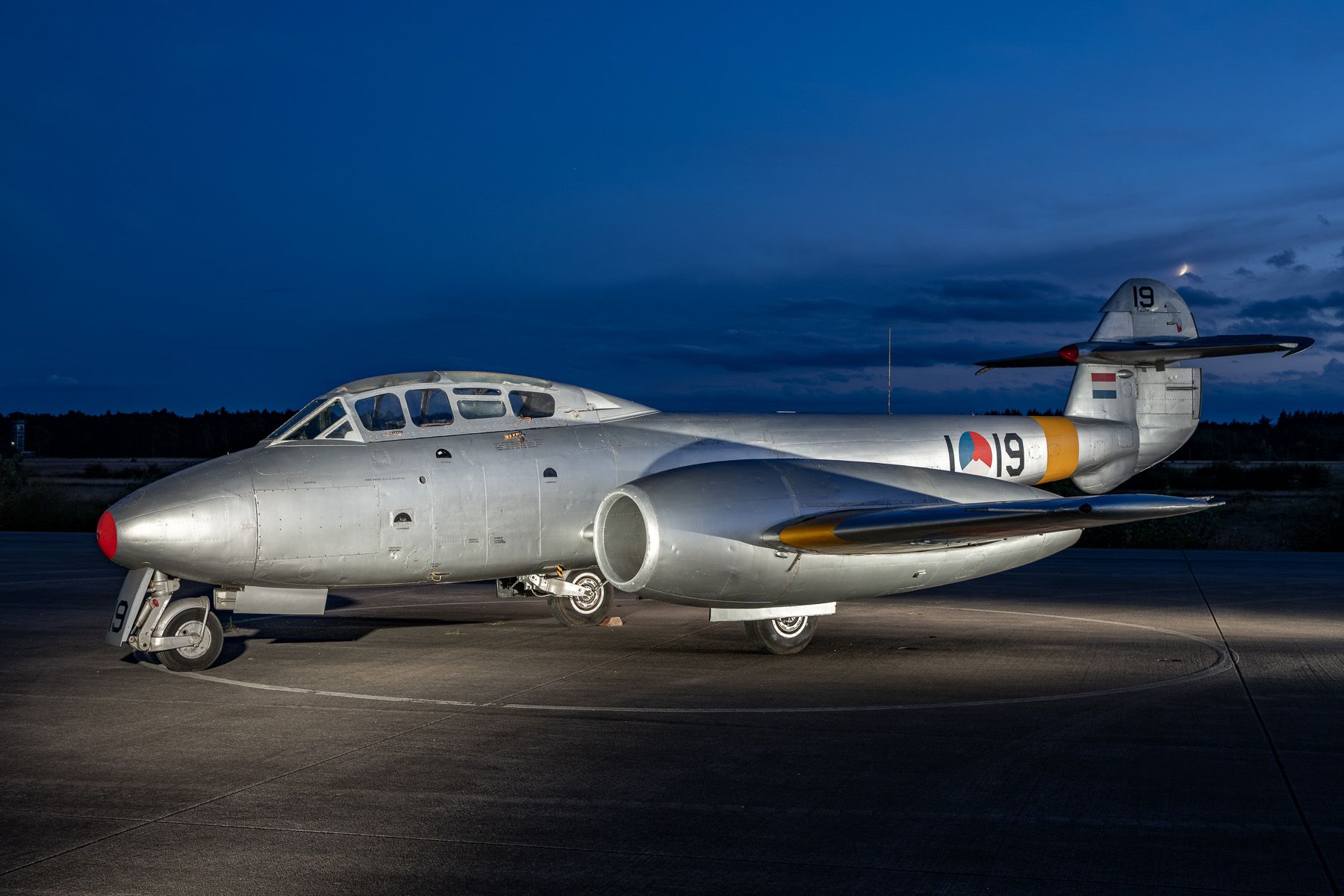
Gloster Meteor T. Mk 7 serial I-19
Another two-seater from NMM’s storage depot is highlighted here. In terms of numbers, the Gloster Meteor fleet was the largest within the Koninklijke Luchtmacht. Operating both the F. Mk 4 and F. Mk 8 that equipped seven air defence squadrons, the need for a dual-seat conversion platform led to the development of the T. Mk 7, which is basically a two-seat F. Mk 4. The KLu received no less than 45 of these trainers from 1949. The last one was retired in 1959, while the Royal Netherlands Navy even continued to operate a handful until 1961.
Meteor T. Mk 7 I-19 was built in 1951 and was allocated Royal Air Force serial WH233. It first flew on 13 February 1952 and one year later, on 24 February 1953, was sold to the KLu. From 20 April 1953 it was used by the Jachtvliegschool (JVS) at Twenthe until 28 September 1953 when it moved to 328 squadron at Soesterberg.
I-19’s career did not pass by flawlessly. First it was damaged in a spin in 1954, and a year later a belly landing had to be made. Following both mishaps, it was repaired and returned to service. It briefly flew with newly formed 700 squadron at Soesterberg in preparation of the expected arrival of Meteor NF Mk.11 night fighters, but when the North American F-86K was chosen instead, I-19 left 700 squadron again. It finally ended up with 326 squadron at Woensdrecht on 10 March 1959, where it was retired soon after, on 15 May that same year.
Although earmarked for scrapping, it survived the axe and became a gate guard at Woensdrecht in November 1960. In 1975 it was extensively restored and six years later, it was presented to the MLM at Kamp Zeist. Then followed a number of relocations, first into storage at Gilze-Rijen, then to Twenthe in July 1988 as an exhibit along with TF-104G D-5803 (see above in this report) and when that base closed, it once more moved to Soesterberg to become part of the museum collection again, although placed in depot.
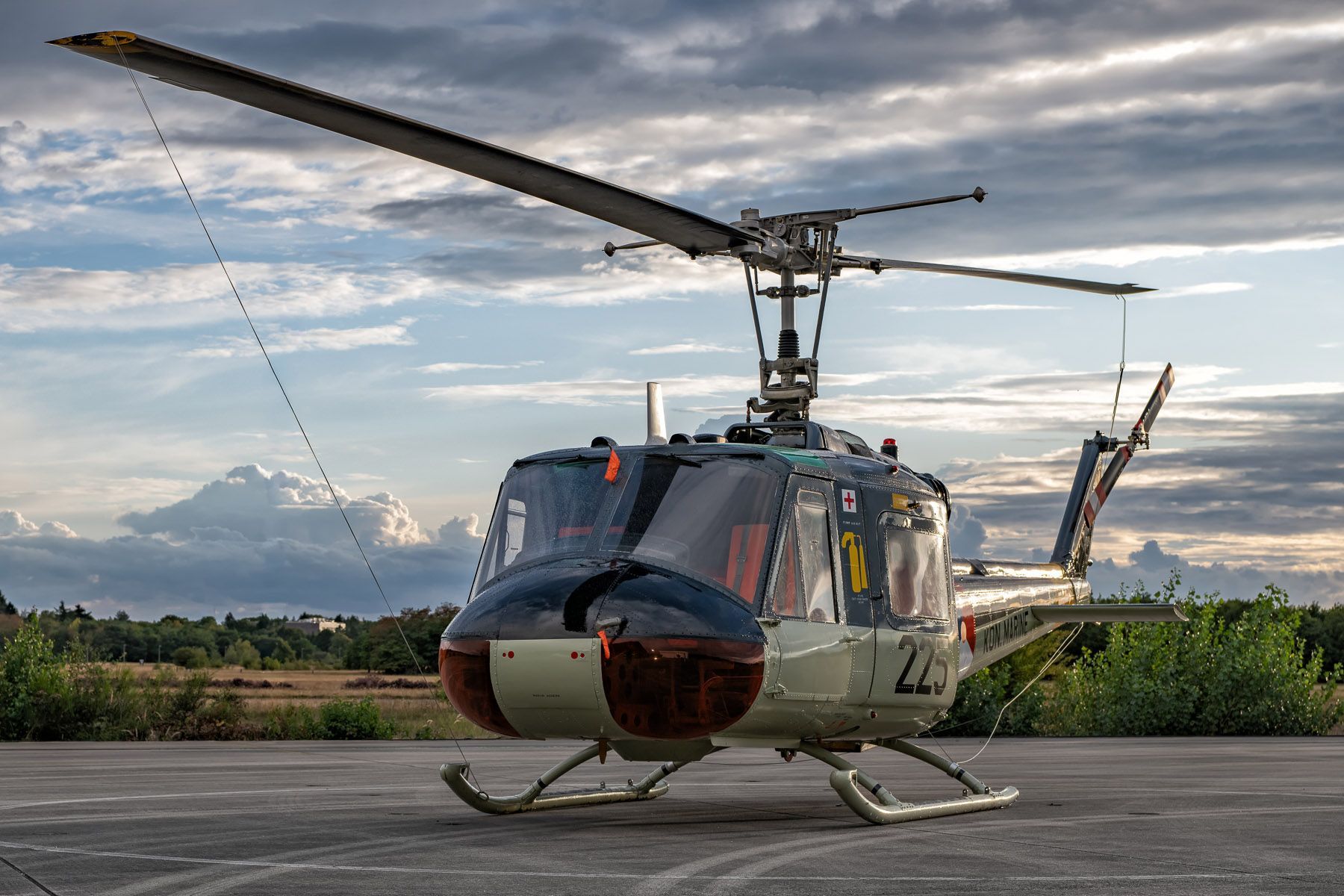
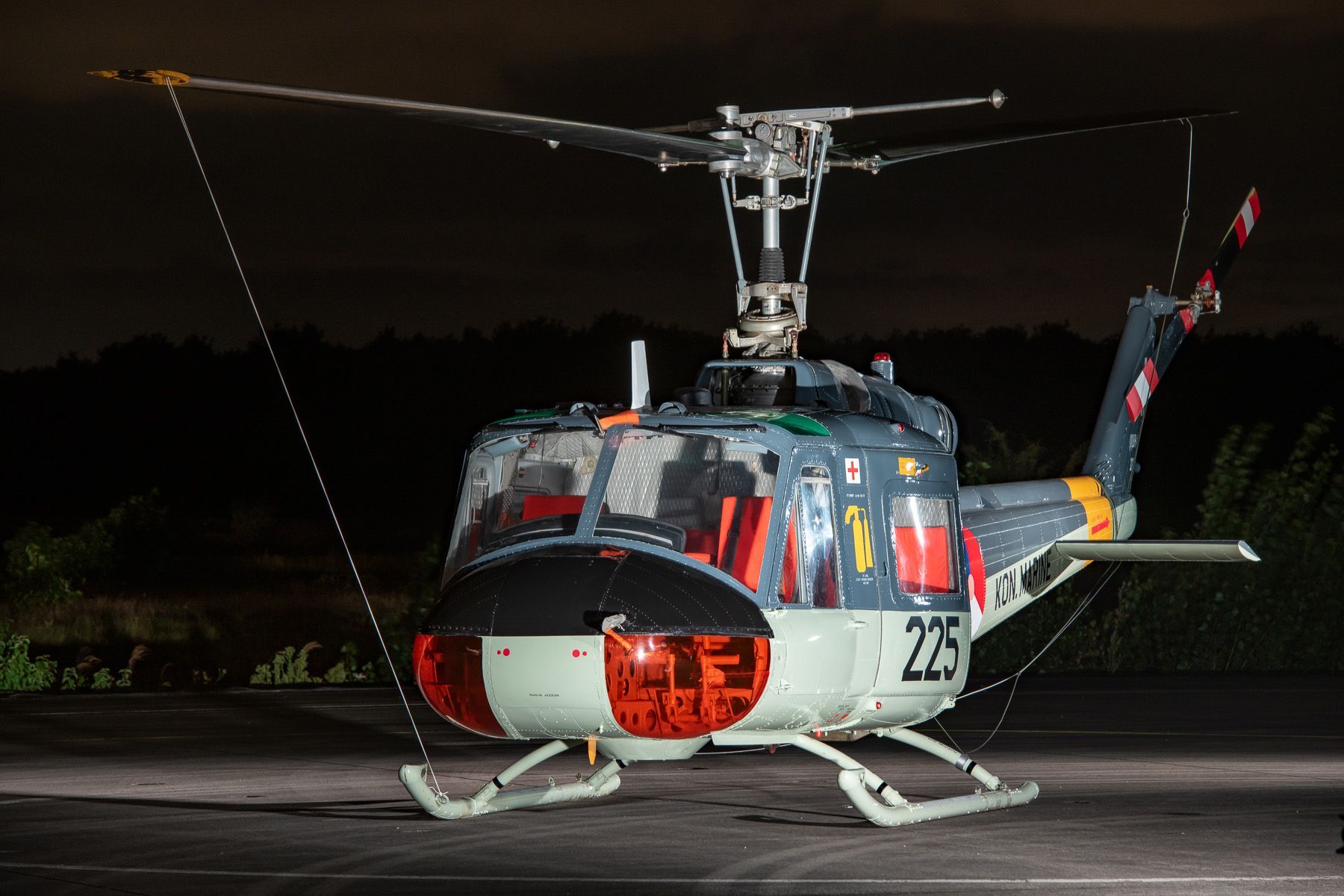
Agusta-Bell AB204B serial 225
Last but certainly not least, an interesting helicopter was displayed during the nightshoot. In 1962, the Marineluchtvaartdienst (MLD) obtained eight Agusta-Bell AB204B helicopters (designated (I)UH-1 by the Royal Netherlands Navy) mainly for transport and utility duties, although some were fitted with a hoist for search-and-rescue missions. Initially these helicopters were based at Marinevliegkamp (Naval Air Station) Valkenburg as part of Vliegtuigsquadron 7 (VSQ 7) while a pair was detached to VSQ 1 at Hato on Curacao, Dutch Antilles until 1972 to serve the locally based Korps Mariniers (Marine Corps, which is part of the Royal Netherlands Navy). After one had to be written off in an unfortunate accident in 1964, a replacement was bought in Italy. In 1974, VSQ 7 moved to Marinevliegkamp De Kooy near Den Helder. In 1978, the last Hueys were retired.
AB204B serial 225 (c/n 3023) was taken on charge on 14 December 1962, however, it was apparently already phased out in April 1969. Following the type’s retirement in 1978, the helicopter ended up in Sweden along with several other former MLD Hueys. In the late 1990s, 225 returned to the Netherlands joining the collection of the MLM. It is currently preserved in an immaculate condition, and its tail marking “K” refers to its last home base De Kooy.
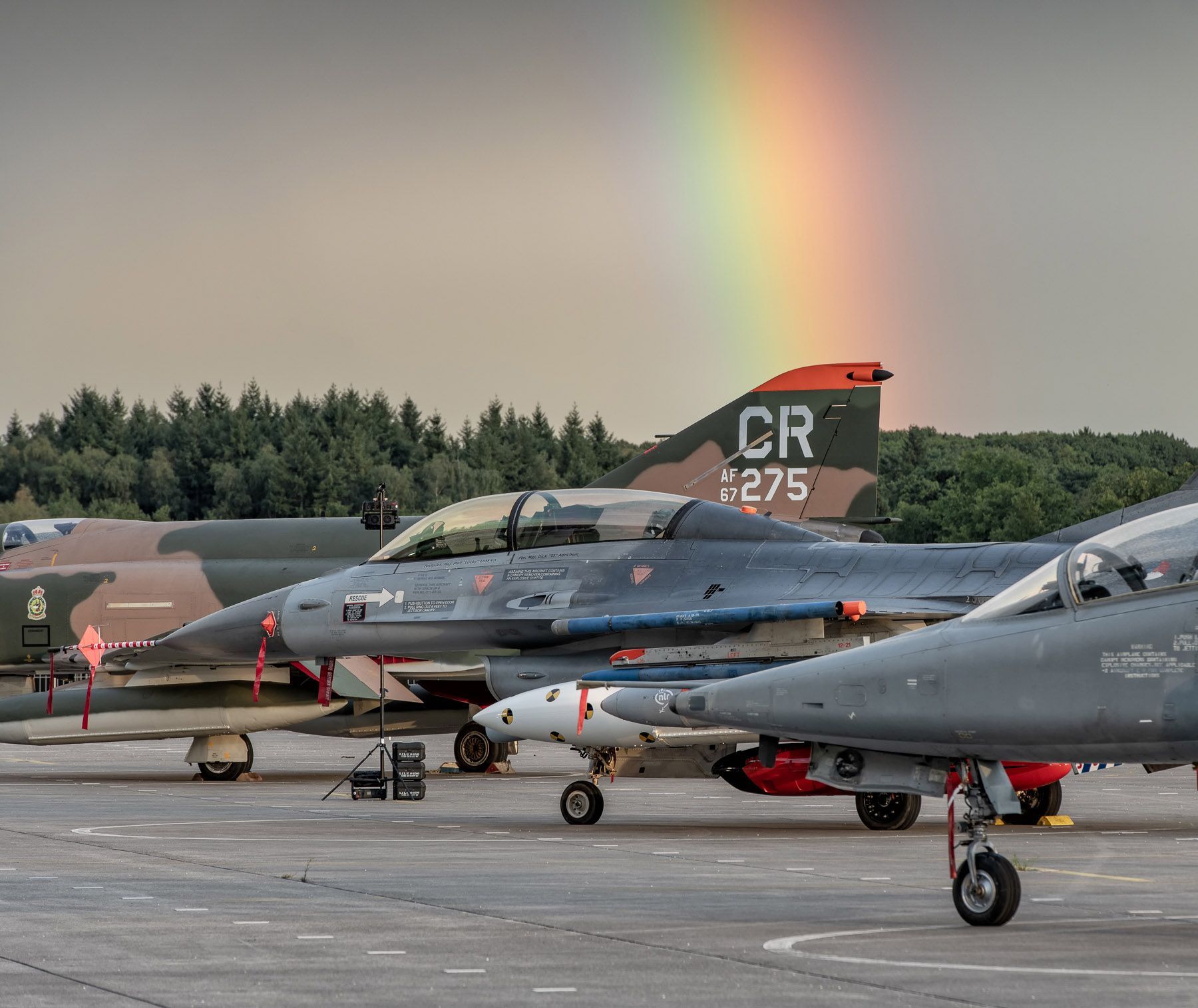
That concludes this line up, which of course is just a small portion of the museum’s great collection. When faced with limited space, it is always a choice which aircraft to put on display, and what to store for possible later use. Everyone has their opinions and preferences, but apart from that, as long as all assets are taken care of with lots of TLC, the aircraft will be saved for future generations. And additional nightshoots! ■
The author would like to thank the Nationaal Militair Museum for arranging the nightshoot as well as their valuable background information presented on their website.
